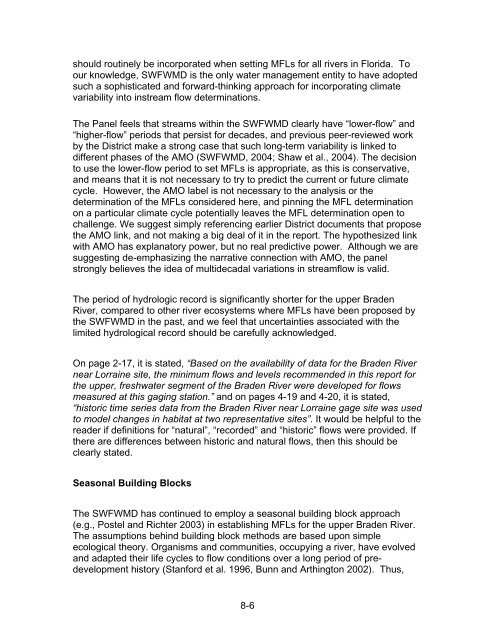Chapter 1 Minimum Flows and Levels - Southwest Florida Water ...
Chapter 1 Minimum Flows and Levels - Southwest Florida Water ...
Chapter 1 Minimum Flows and Levels - Southwest Florida Water ...
You also want an ePaper? Increase the reach of your titles
YUMPU automatically turns print PDFs into web optimized ePapers that Google loves.
should routinely be incorporated when setting MFLs for all rivers in <strong>Florida</strong>. To<br />
our knowledge, SWFWMD is the only water management entity to have adopted<br />
such a sophisticated <strong>and</strong> forward-thinking approach for incorporating climate<br />
variability into instream flow determinations.<br />
The Panel feels that streams within the SWFWMD clearly have “lower-flow” <strong>and</strong><br />
“higher-flow” periods that persist for decades, <strong>and</strong> previous peer-reviewed work<br />
by the District make a strong case that such long-term variability is linked to<br />
different phases of the AMO (SWFWMD, 2004; Shaw et al., 2004). The decision<br />
to use the lower-flow period to set MFLs is appropriate, as this is conservative,<br />
<strong>and</strong> means that it is not necessary to try to predict the current or future climate<br />
cycle. However, the AMO label is not necessary to the analysis or the<br />
determination of the MFLs considered here, <strong>and</strong> pinning the MFL determination<br />
on a particular climate cycle potentially leaves the MFL determination open to<br />
challenge. We suggest simply referencing earlier District documents that propose<br />
the AMO link, <strong>and</strong> not making a big deal of it in the report. The hypothesized link<br />
with AMO has explanatory power, but no real predictive power. Although we are<br />
suggesting de-emphasizing the narrative connection with AMO, the panel<br />
strongly believes the idea of multidecadal variations in streamflow is valid.<br />
The period of hydrologic record is significantly shorter for the upper Braden<br />
River, compared to other river ecosystems where MFLs have been proposed by<br />
the SWFWMD in the past, <strong>and</strong> we feel that uncertainties associated with the<br />
limited hydrological record should be carefully acknowledged.<br />
On page 2-17, it is stated, “Based on the availability of data for the Braden River<br />
near Lorraine site, the minimum flows <strong>and</strong> levels recommended in this report for<br />
the upper, freshwater segment of the Braden River were developed for flows<br />
measured at this gaging station.” <strong>and</strong> on pages 4-19 <strong>and</strong> 4-20, it is stated,<br />
“historic time series data from the Braden River near Lorraine gage site was used<br />
to model changes in habitat at two representative sites”. It would be helpful to the<br />
reader if definitions for “natural”, “recorded” <strong>and</strong> “historic” flows were provided. If<br />
there are differences between historic <strong>and</strong> natural flows, then this should be<br />
clearly stated.<br />
Seasonal Building Blocks<br />
The SWFWMD has continued to employ a seasonal building block approach<br />
(e.g., Postel <strong>and</strong> Richter 2003) in establishing MFLs for the upper Braden River.<br />
The assumptions behind building block methods are based upon simple<br />
ecological theory. Organisms <strong>and</strong> communities, occupying a river, have evolved<br />
<strong>and</strong> adapted their life cycles to flow conditions over a long period of predevelopment<br />
history (Stanford et al. 1996, Bunn <strong>and</strong> Arthington 2002). Thus,<br />
8-6
















